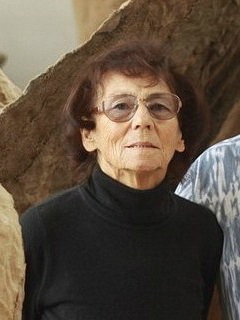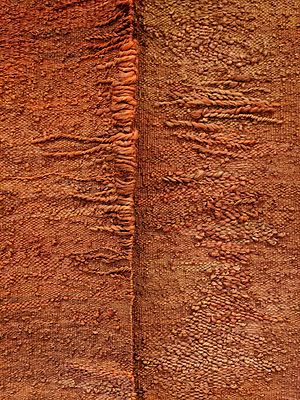Magdalena Abakanowicz facts for kids
Quick facts for kids
Magdalena Abakanowicz
|
|
|---|---|

Magdalena Abakanowicz in her studio
|
|
| Born | 20 June 1930 Falenty, Poland
|
| Died | 20 April 2017 (aged 86) |
| Nationality | Polish |
| Education | Warsaw Academy of Fine Arts |
| Known for | sculpture, fiber art |
| Movement | Postminimalism |
| Awards | Herder Prize (1979) Leonardo da Vinci World Award of Arts (1999) |
Magdalena Abakanowicz (born June 20, 1930 – died April 20, 2017) was a famous Polish artist. She was known for making sculptures and art from fibers. She often used textiles, like fabric and rope, to create large sculptures. She also made big art pieces that were placed outdoors. Many people consider her one of Poland's most important artists known around the world. She taught art at the Academy of Fine Arts in Poznań, Poland, for many years. She also taught for a short time at the University of California, Los Angeles in 1984.
Contents
Magdalena Abakanowicz: Early Life and Challenges
Magdalena Abakanowicz was born into a noble family in Falenty, Poland. Her family had a long history in Poland. Her father's family came from Tatar people who had lived in Poland for a long time. They had moved to Poland from Russia after the October Revolution.
When Magdalena was a child, her family had to leave their home because of the Polish–Soviet War. They moved to the city of Gdańsk. When she was nine, Nazi Germany invaded and took over Poland, starting World War II. Her family lived near Warsaw during the war. They were part of the Polish resistance, fighting against the occupation. At age 14, she worked as a nurse's helper in a Warsaw hospital. Seeing the effects of war up close deeply influenced her future art. After the war, her family moved to Tczew, hoping for a new start.
After the war, Poland came under communist rule. The government decided that only one type of art, called Socialist realism, was allowed. This art style was supposed to be realistic and show socialist ideas. Other art styles, like Modernism, were banned and censored. Even with these strict rules, Magdalena was determined to create her own unique art.
How Magdalena Abakanowicz Studied Art
Magdalena finished high school in Tczew and then studied art in Gdynia. In 1950, she moved to Warsaw to attend the Warsaw Academy of Fine Arts. This was the top art school in Poland. To get in, she had to hide her noble family background. This was because the communist government favored people from working-class families.
Her time at the university (1950–1954) was difficult. The communist government controlled all art forms. Artists had to follow strict rules that made art serve the needs of the state. Only traditional, realistic art was taught. The Warsaw Academy was closely watched by the government. Magdalena found the school's atmosphere very "rigid" and "conservative."
While studying, she had to take classes in textile design. She learned weaving, screen printing, and how to design with fibers. These skills and her teachers greatly influenced her work. They also influenced other important Polish artists of that time.
Magdalena Abakanowicz's First Artworks
After finishing her studies, Magdalena began creating her first art pieces. Many of her early works were lost or damaged because she moved around so much. Only a few delicate plant drawings survived. Between 1956 and 1959, she made large paintings using gouache and watercolors on paper and linen sheets. These works showed imaginary plants, birds, fish, and seashells. They were described as "biomorphic," meaning they looked like living forms. These early pieces showed her interest in nature and its growth.
Around this time, Poland started to become more open. This was after the death of Soviet leader Joseph Stalin in 1953. In 1956, Poland's new leader, Władysław Gomułka, brought big social and cultural changes. Art became more free, and the old strict art rules were criticized.
Polish artists were allowed to travel to Western cities like Paris and New York City. This let them see new art styles. This freedom influenced Magdalena. She began to feel her early work was too decorative and lacked structure. She started to be influenced by Constructivism, an art style that used geometric shapes. But she never fully adopted it. She wanted her art to be more personal and touchable. So, she started using weaving in her art.
In 1960, she had her first solo art show in Warsaw. It included four weavings along with her paintings. This show helped her become known in the Polish textile art movement. It also led to her being invited to the first Biennale Internationale de le Tapisserie in Lausanne, Switzerland, in 1962. This event helped her gain international fame.
Famous Art Series by Magdalena Abakanowicz
The Abakans Series
The 1960s were very important for Magdalena's art. In 1967, she started making large, three-dimensional fiber artworks called Abakans. These were included in a major exhibition in 1969 at the Museum of Modern Art in New York. Magdalena and other artists in the show were changing ideas about what art could be. They used soft, unexpected materials in new ways. This placed her art within the Postminimalism art movement. Magdalena wanted to show that fiber art could be powerful and complex, not just for practical use.
Each Abakan was made using her own special weaving technique. She often found materials like sisal ropes from harbors. She would twist them into threads and dye them. She also used hemp, flax, wool, and horsehair. These Abakans were hung from the ceiling and could be very large, sometimes almost touching the floor. They often looked like eggs or wombs, hinting at life and birth.
One of her large Abakans is at the Nasher Sculpture Center in Dallas, Texas. It's made of five big panels of recycled sisal, dyed a burnt brown color.
Humanoid Sculptures
In the 1970s and 1980s, Magdalena started using different materials and making larger sculptures. She began a series of human-like and abstract sculptures. She made them from coarse sackcloth, which she sewed together and hardened with synthetic resins. These works were more recognizable as figures but still had a mysterious, unclear quality.
- In 1974-1975, she created Alterations. This was a row of twelve hollow, headless human figures sitting.
- From 1973–1975, she made Heads, which were huge, solid forms that looked like human heads without faces.
- From 1976-1980, she created Backs, a series of eighty slightly different sculptures of the human torso.

In 1986-87, she made Crowd I, a series of fifty standing figures. She also returned to organic shapes with her Embryology series. This included dozens of soft, egg-like lumps of different sizes. They were spread out in an exhibition room in Vienna in 1980.
These human-like sculptures from the 1970s and 1980s explored human culture and our place in modern society. The many similar human forms showed feelings of confusion and being anonymous in a crowd. These works were connected to Magdalena's life under a communist government. This government often tried to control individual creativity and make everyone conform. These sculptures were different from her earlier Abakan series. The Abakans were powerful on their own, but the figurative sculptures lost their individual look to become part of a group.
In the late 1980s and 1990s, Magdalena started using metals like bronze for her sculptures. She also used wood, stone, and clay. Her works from this time include Bronze Crowd (1990–91) and Puellae (1992).
Her work Caminando sold for a record price in Poland in 2019. This record was broken again in 2021 by her works Crowd III and Bambini.
The War Games Series
One of Magdalena's unique art series is called War Games. These are huge sculptures made from large tree trunks. She removed their branches and bark, then partly wrapped them in rags and steel hoops. These sculptures stand on metal frames. As the name suggests, they look very military-like, sometimes compared to artillery vehicles. In the 1990s, Magdalena also designed a model for an eco-friendly city and even choreographed dances.
The Agora Project

Magdalena's last major work is a project called Agora. It's a permanent art installation in Chicago's Grant Park. It has 106 cast iron figures, each about nine feet tall. All the figures look similar but have small differences. Magdalena and her three helpers made models for each figure by hand. The figures were cast between 2004 and 2006. The surface of each figure looks like tree bark or wrinkled skin. The artwork makes you feel like you're in a crowded place, which is why it's called "agora" (a Greek word for a public gathering place). All the figures end at the torso, making them look mysterious and anonymous.
Awards and Honors for Magdalena Abakanowicz
Magdalena Abakanowicz received many important awards and honors for her art:
- Grand Prix of São Paulo Biennale, Brazil (1965)
- Herder Prize, Vienna, Austria (1979)
- Jurzykowski Prize, New York City (1982)
- Award for Distinction in Sculpture from the SculptureCenter, New York (1993)
- Commander Cross with Star of the Order of Polonia Restituta (1998)
- Pour le Mérite for Sciences and Arts, Berlin, Germany (1999)
- Officier de L'Ordre des Arts et des Lettres, Paris, France (1999)
- Leonardo da Vinci World Award of Arts, Norway (1999)
- Knight of the Order of Merit of the Italian Republic (2000)
- Visionaries! Award from the American Craft Museum (2000)
- Lifetime Achievement in Contemporary Sculpture Award, International Sculpture Center (2005)
- Germany's Star of the Grand Cross for Service to Germany (2010)
She also received many honorary doctorates from universities around the world, including:
- Royal College of Art, London, England (1974)
- Rhode Island School of Design, Providence, Rhode Island (1992)
- American Academy of Arts and Letters, New York City (1996)
- Pratt Institute, New York (2000)
- School of the Art Institute of Chicago, Chicago, Illinois (2002)
Magdalena Abakanowicz: Inspiring Quotes
Magdalena Abakanowicz often shared her thoughts on art and life. Here are some of her famous quotes:
"I feel amazed by quantity where counting no longer makes sense. By how unique each thing is within such a large group. By creatures of nature gathered in herds, groups, species, where each individual, while part of the mass, still has its own special features. A crowd of people, birds, insects, or leaves is a mysterious collection of different versions of the same thing. It's nature's puzzle of not wanting to repeat things exactly or not being able to. Just as a human hand cannot repeat its own movement, I use this surprising rule, moving my own still groups into that rhythm."
"Art will remain the most amazing thing humans do. It comes from the struggle between wisdom and madness, between dreams and reality in our minds."
See also
 In Spanish: Magdalena Abakanowicz para niños
In Spanish: Magdalena Abakanowicz para niños
- Abakanowicz
- List of Polish artists
- Socialist realism
- Birds of Knowledge of Good and Evil
- Agora
- Fiber art
Images for kids
-
Nierozpoznani ("The Unrecognised Ones") (2002) in the Cytadela park, Poznań, Poland (whole installation)
-
Space of Unknown Growth (Europos Parkas, Lithuania)



